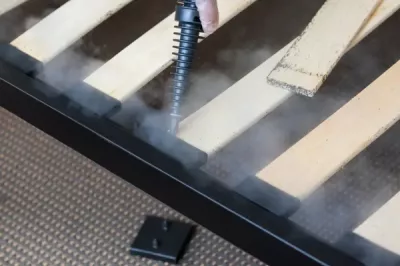Moths
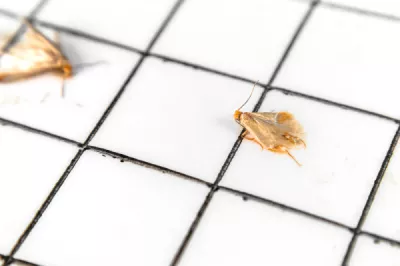
Clothes Moths - Tineola bissesilia
Also known as a Carpet Moth - the larvae of this textile pest feed on natural fabrics. If you've ever gone into your wardrobe and found a penny sized hole in your clothes. This is probably the cause.
Though they are winged - males do not often fly, female moths never fly. Previously this was a pest of dusty environments such as museums. Nowadays this is a common domestic pest feeding on natural fibres such as cotton, wool and silk.
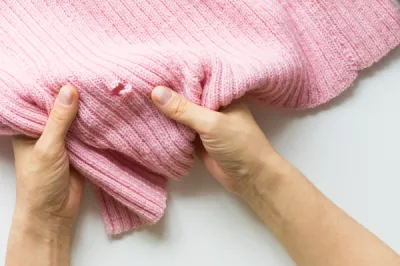
Signs of a moth infestation
What to look for...
- Remember, the straw coloured clothes moth does not actually feed on fabrics.
- It's the white larvae which do that.
- Look in dark, dusty corners as these are good harbourages.
- They are called Common Clothes Moth but will feed on carpet too.
- There are 3 other types of moths that cause damage - these are as follows:
- Case Bearing Clothes Moth - the damage to fabric tends to be more circular holes, unlike the clothes moth holes, which are irregular.
- Brown House Moth - this is the most common type of domestic moth, feed on animal based materials such as leather.
- White Shouldered House Moth - rare species that feeds less on natural fabrics than the other species.
Where to look...
- Start with the vacuum cleaner which will often hoover up but not destroy the casing of the larvae.
- Pull furniture away from walls.
- Lay your clothes out, particularly those that haven't been worn or washed in a while and comb through with a clothes brush.
- Focus on silk, cotton and wool. Clothes and carpet!
- Our team can help guide you through this process, get in touch below.
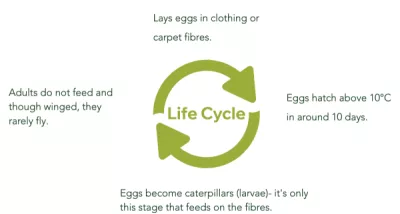
Moth prevention and control
Prevention
- If fabric items or textiles are out of use, store them in a sealed bag to prevent eggs developing.
- Housekeeping - vacuum harbourages (corners, cracks, crevices) regularly.
- Change vacuum bag regularly.
- Wash clothes regularly - see control for temperatures.
- Close doors, shut windows where possible to prevent moths entering/moving through.
- For ongoing prevention greenpest can install fly screens and offer a hormone based system to prevent moths indefinitely.
Control
- Empty the vacuum cleaner outside so the eggs are not remaining in your house.
- Change vacuum bags regularly.
- Hot! Washing clothes above 40°C destroys eggs.
- (and cold) if you can find it - temperatures below -8°C have the same effect!
- Wipe down and clean intensively pieces of furniture, thorough vacuum behind.
- Remember moths can enter the home the same way you do! Check bags, containers, suitcases and anything else you take on your travels.
- Hygiene! Thoroughly clean the room, vacuuming all cracks and crevices.
- Wash clothes at high temperatures (where suitable) - above 60°C.
- These pests nest within dusty areas as well as clothes, so vacuum as much as possible.
- Synthetic fibres will not attract these pests.
Entry level treatment applied as a crack and a crevice treatment. This treatment is suitable for direct application to most fabrics.
This is a powerful, residual insecticide meaning it has an effect after application. It's application as a spray means it is best conducted with additional, more extensive treatments.
The nature of the spray requires premises to be vacated for 4 hours post treatment.
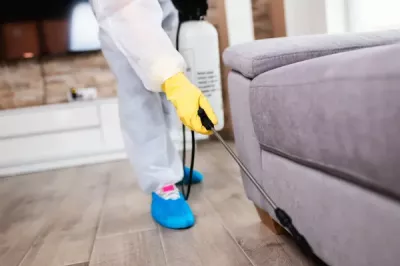
Fumigation: A treatment which can often access harbourages the spray is unable to. This is normally applied concurrently with a spray as it lacks a residual effect.
This is a vapour based insecticide output from an industrial fogger. It is quick and effective at moth control but over the long term has minimal effect.
Premises must be vacated for 4 hours post application.
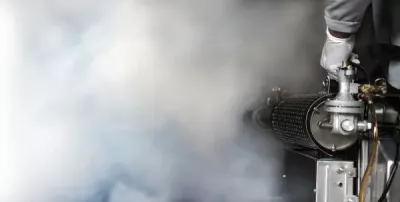
A completely non-toxic treatment which acts by disrupting life cycle through dramatic temperature changes. This treatment eliminates both moths and eggs completely.
This is applied either through a superheated steam which reaches all the cracks and crevices we find bedbugs in.
Alternatively - it is possible to heat the entire room to a high temperature however this is very energy intensive.
